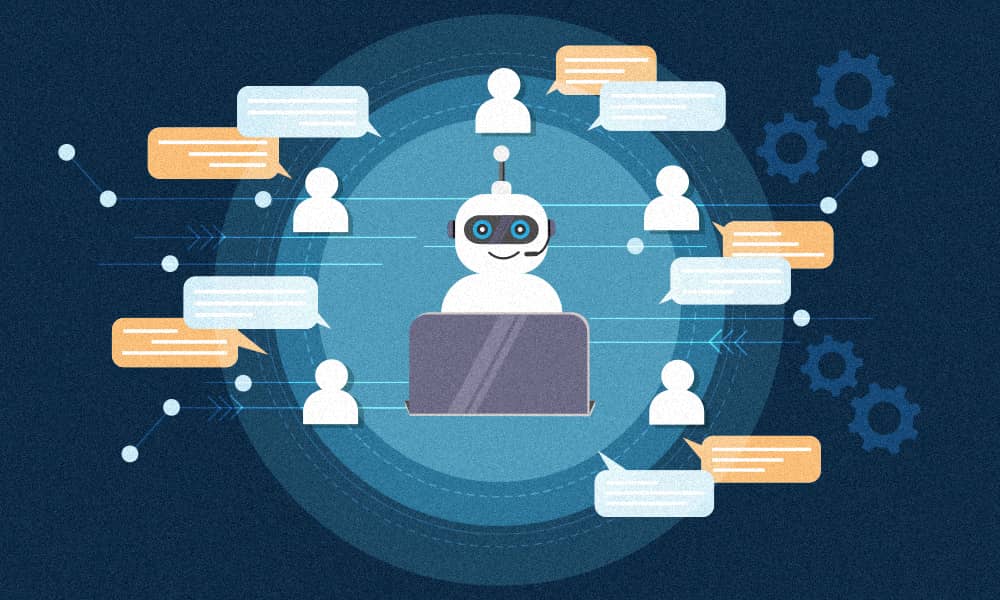
The Role of AI Chatbots in Modern Web Applications
AI chatbots have transformed the way modern web applications function, providing real-time assistance, enhancing user experiences, and automating business processes. As artificial intelligence (AI) technologies, such as natural language processing (NLP) and machine learning (ML), become more advanced, chatbots are growing in their capacity to understand and respond to human interactions.
The key features of The Role of AI Chatbots in Modern Web Applications:
1. Customer Support Automation: AI chatbots provide 24/7 customer service, handling repetitive queries, reducing response time, and improving customer satisfaction. They ensure round-the-clock availability and reduce the workload for human agents.
2. Personalization: Chatbots leverage user data and past interactions to offer personalized recommendations, answers, and product suggestions, creating tailored experiences that cater to individual needs and preferences.
3. Natural Language Processing (NLP): NLP allows chatbots to understand and interpret human language more naturally. They can comprehend context, detect sentiment, and engage in more meaningful conversations.
4. Machine Learning (ML) Capabilities: AI chatbots continuously learn and improve based on past interactions through machine learning, making their responses more accurate and relevant over time.
5. Lead Generation and Sales Support: AI chatbots assist in qualifying leads, gathering user data, and guiding potential customers through the sales funnel. This accelerates sales processes and improves conversion rates in web applications.
6. E-commerce Assistance: In e-commerce, AI chatbots act as virtual shopping assistants, helping users find products, offering suggestions, answering questions, and even facilitating transactions directly in the app.
7. Data Collection and Analytics: Chatbots gather valuable insights from user interactions, providing businesses with data on customer behavior, preferences, and pain points, helping inform future strategies.
8. Voice-Enabled Interactions: With the integration of voice-recognition technology, chatbots can understand and respond to spoken language, increasing accessibility and enhancing the user experience on platforms with voice support.
9. Cost Efficiency: AI chatbots reduce operational costs by minimizing the need for large customer service teams and automating various business processes, making them a cost-effective solution for many organizations.
10. Seamless Integration with APIs: AI chatbots can connect with APIs to access real-time data and services, enabling actions like booking appointments, making payments, or checking order statuses directly within web applications.
11. Multi-Platform Support: Modern AI chatbots can function across different platforms, from web apps to mobile applications and social media channels, ensuring a consistent user experience no matter the device or platform.
12. Conversational AI: Advanced conversational AI systems allow chatbots to engage in more human-like interactions, understanding complex questions, multi-turn dialogues, and emotional tones, making the experience smoother for users.
13. Improved User Experience: By offering fast, personalized, and intelligent responses, chatbots enhance user satisfaction and engagement, making modern web applications more intuitive and efficient.
14. Task Automation: AI chatbots can automate various tasks such as booking appointments, sending notifications, and performing repetitive administrative functions, streamlining workflows for both businesses and users.
15. Scalability: Chatbots provide a scalable solution for growing businesses, as they can handle an increasing number of user interactions without needing additional resources, making them ideal for companies looking to expand.
The Role of AI Chatbots in Modern Web Applications
1. Evolution of Chatbots
- The Early Days of Chatbots: Chatbots have been around since the 1960s, with early examples like ELIZA and PARRY. However, these early bots had limited capabilities, mainly responding based on pre-programmed rules. They lacked real comprehension of human language.
- Rise of AI and Modern Chatbots: The integration of AI, especially with advancements in NLP and machine learning, has evolved chatbots from simple text-based tools to sophisticated AI-driven systems capable of understanding context, providing personalized responses, and even predicting user needs.
- Transition into Web Applications:
Modern web applications leverage these AI advancements to integrate chatbots as core components. This transition has been driven by the increasing demand for better customer engagement, support, and automation.
2. Types of AI Chatbots in Web Applications
- Rule-Based Chatbots: These chatbots still operate on if-then logic but are much more advanced than their predecessors. They are often used in FAQ-based web applications where limited or specific information is required.
- AI-Powered Chatbots: Leveraging NLP, AI chatbots can handle more complex queries, adapt to different user inputs, and even learn from previous interactions. They offer more dynamic and fluid conversations than rule-based bots.
Voice-Enabled Chatbots: With the rise of smart devices, voice-enabled chatbots, such as those integrated into smart speakers, are becoming more common in web apps. These bots allow users to interact using spoken commands, increasing accessibility.
3. Integration of AI Chatbots in Modern Web Applications
- Customer Support Automation: One of the most common uses of AI chatbots is customer service. These chatbots can handle repetitive customer queries, provide instant responses, and help reduce the workload of human agents. Many web applications have 24/7 chatbot support integrated directly into their interface.
- E-commerce Assistance: In the e-commerce sector, AI chatbots are playing a significant role in helping users find products, get recommendations, and even complete transactions. They act as virtual shopping assistants, helping users through the buying process and answering product-related queries.
- Lead Generation and Sales Support:
AI chatbots can gather information from potential customers visiting web applications, qualify leads, and direct them to the appropriate sales team, significantly enhancing lead generation and sales conversion.
4. Enhancing User Experience with AI Chatbots
- Personalization: Chatbots can analyze past interactions and user data to provide highly personalized responses. This enhances user experience by catering to individual preferences and needs. For example, in a web application, an AI chatbot might recommend products or services based on the user’s previous behavior.
- 24/7 Availability: AI chatbots ensure that users receive assistance anytime they need it, significantly improving user satisfaction. The around-the-clock availability of chatbots makes web applications more efficient and user-friendly, especially for global businesses catering to different time zones.
- Reduced Response Time:
Unlike human agents, AI chatbots can instantly respond to user queries, reducing wait times and enhancing the overall user experience.
5. AI Chatbots as Business Tools
- Data Collection and Analysis: Chatbots collect vast amounts of user data from conversations, providing insights into customer behavior and preferences. This data can be invaluable for businesses in terms of improving their services and offerings.
- Automating Repetitive Tasks: From scheduling appointments to sending reminders, AI chatbots can handle various administrative tasks automatically. This not only reduces the workload for employees but also ensures more efficient operations within web applications.
- Cost Efficiency:
By automating a large portion of customer interactions, chatbots can reduce the need for large customer service teams. This results in cost savings for businesses, making chatbots an appealing tool for companies looking to scale their operations without drastically increasing costs.
6. The Technical Side of AI Chatbots
- Natural Language Processing (NLP): NLP is a cornerstone of AI chatbot development. It allows chatbots to understand and process human language, making conversations more natural. NLP techniques such as sentiment analysis enable chatbots to detect the emotional tone of users and respond accordingly.
- Machine Learning (ML) Algorithms: Modern chatbots rely on machine learning to improve their performance over time. They learn from previous interactions, improving their accuracy in understanding and responding to user queries.
- Integration with Web APIs: Chatbots can be integrated into web applications through APIs, allowing them to access real-time data and perform tasks like booking a flight, scheduling appointments, or processing payments.
- Multi-Platform Support:
Many AI chatbots are designed to function seamlessly across various platforms, from web applications to mobile apps and social media. This multi-platform capability ensures consistent user experiences regardless of the platform being used.
7. The Future of AI Chatbots in Web Applications
Conversational AI: Conversational AI: The future of AI chatbots lies in conversational AI, where chatbots will engage in more human-like conversations, understanding nuances, context, and emotions. These advancements will make chatbot interactions feel more natural and intuitive.
- Advanced Personalization: As AI becomes more adept at analyzing user data, chatbots will offer deeper levels of personalization. They will be able to predict user needs before they are explicitly stated, making web applications even more user-centric.
- Augmented Reality (AR) and AI Chatbots: Future web applications may integrate AI chatbots with AR technologies. For example, an AI chatbot could guide users through a virtual store, enhancing the e-commerce experience.
- Ethical and Privacy Considerations:
As AI chatbots evolve, concerns about user privacy, data security, and ethical AI use will also become more prevalent. Web applications will need to balance chatbot innovation with robust privacy policies and transparent data practices.
Conclusion
AI chatbots are reshaping the landscape of modern web applications by providing real-time, personalized assistance, automating processes, and improving user engagement. From customer support to e-commerce, AI-powered bots have proven to be valuable assets for businesses looking to enhance user experiences and drive efficiency. As the technology continues to evolve, AI chatbots will become even more integral to web applications, leading to richer, more interactive online experiences.

Leave a Comment